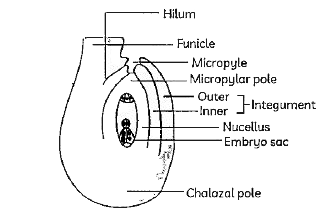Proliferation of integumentary cells at the micropylar region of the ovule in castor develops
Aril
Funicle
Caruncle
Apophysis
The correct Answer is:3
Step by step video, text & image solution for Proliferation of integumentary cells at the micropylar region of the ovule in castor develops by Biology experts to help you in doubts & scoring excellent marks in Class 12 exams.
Similar Questions
Megasporogenesis is defined as the process of formation of megaspores from the megaspore mother cell (MMC). MMC is a diploid cell This process occurs inside the nucellus of the developing ovule.

Ovules generally differentiate a Megaspore mother cell/s in the micropylar region of the nucellus.View SolutionProliferation of cancer cells is not limited because of:
View Solution
Knowledge Check
- Question 1 - Select One
In castor proliveration of the outer integumentary cells at micropylar region
Alacks hygroscopic abilityBattarct ants and heps in myrmecophilyCis called epiblastDstores sugary substances - Question 2 - Select One
Largest cell of the ovule is
AMegaspore mother cellBAntipodal cellCCentral cellDSize of cells variable. - Question 3 - Select One
Largest cell of the ovule is
AMegaspore mother cellBAntipodal cellCCentral cellDSize of cells variable
Integumentary outgrowht present over the microphyle of Castor is
View SolutionThe cells in the embryo sac located at the micropylar end are :
View SolutionDedifferentiated cells are formed in the region of
View SolutionRoot hairs develop from the region of
View SolutionOpposite the micropylar end, representing the basal part of the ovule is called:
View Solution

